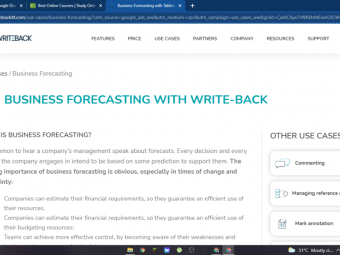Introduction To The Economics Of Public Services Regulation
Tags: Economics
A smooth introduction to the complex theory and practice of the regulation of public services
Last updated 2022-01-10 | 4.8
- Understand WHY key essential public services need some regulatory supervision- Learn HOW to think through the regulatory needs as an economist
- Have a good sense of HOW to regulate WHAT and WHEN
What you'll learn
* Requirements
* Solid knowledge of monopoly theory from basic microeconomics classes. It is at the core of everything you will see in this course.* For some of the readings
* you need to know how to set up an optimization problem under constraint.
* You also need to be able to have a sense of synthesis since we will cover a lot.
Description
This course focuses on how best to regulate (public or private) firms responsible for the delivery of what are commonly viewed as public services in the context in which the service providers enjoy significant market power. The lectures get into both the theory and the practice of regulation. The main illustrations of the concepts are from the infrastructure industries (airports, energy, rail, roads, ports, telecoms, water and sanitation). These sectors represent investments and maintenance expenditures of 5-20% of GDP (depending on the level of development of the country) and are major contributors to the growth capacity of countries and of their competitiveness. . They also represent a very large share of the required spending of every household. The poorer the household, often, the higher the share it needs to spend on these public services. Finally, because of the high amounts invested in the sector and the large size of many of the projects required, these services are quite exposed to corruption risks. This is why these services are so politically sensitive and why governments, non-governmental organization and other stakeholders spend a lot of energy debating how best to regulate them.. By the end of the class, you will see that the key issues you’ll learn are representative of many of the trade-offs covered in the ongoing policy debates and you should be able to develop your own view on what desirable regulatory policies and institutions should be in public services, and probably more generally.
Who this course is for:
- Economics students (3rd years BA and, as a complement to more technical classes 1st year MA), Public policy students
- Regulators and their advisors
- NGOs
- Regulated firms
- Concerned residential and non-residential consumers
- Members of regional, national and supranational parliaments
- Economics students
- Public policy students
- Project finance specialists concerned with regulatory issues
Course content
8 sections • 77 lectures
Overview Preview 02:00
The definition and the context of regulation Preview 07:46
A quick reminder of the basic theory on monopolies Preview 13:45
A first look at the regulation on monopolies Preview 09:08
How to assess the size of the problem a regulator faces? Preview 04:57
Stéphane Saussier - About deadweight loss Preview 06:30
On the diversity and evolution of the theory of regulation Preview 07:06
Module 1
- The definition, and the evolution of regulation theory and practice
- A reminder of the basic theory on monopolies
- How to assess the size of the problem a regulator faces?
Overview Preview 02:31
Getting progressively closer to real life Preview 17:35
The game of regulation Preview 06:20
Jose-Antonio Gomez-Ibanez - About the regulatory game Preview 05:37
Some math to get some useful rules of thumbs Preview 04:25
Math Insight : Deriving the Lerner index (or Inverse elasticity rule) Preview 02:23
How to start thinking about the design of regulation in details? Preview 21:05
Module 2
- The relevance of information and institutional distortions
- Regulation as a game
- Some useful rules of thumbs
Overview Preview 02:53
Brief reminder of key concepts Preview 05:09
David Martimort - About agency theories Preview 04:19
What are some main changes in the design of regulation brought about by the uise of agency models?
Optimal regulation under full information Preview 07:39
Optimal regulation when regulators are uncertain about costs Preview 05:05
Phil Burns - About regulatory practice Preview 08:07
What are the practical aspects of how regulation has evolved to minimize the consequences of the asymmetry of information between the utility regulator and the companies it regulates?
Why imperfect costs information makes regulation imperfect? Preview 05:10
A first look at regulation in practice Preview 08:22
Math Insight : Computing the Rate of Return (RoR) Preview 04:46
Impact of information asymmetry on optimal regulatory choice Preview 09:49
Math Insight : The drivers of regulatory options Preview 05:04
Module 3
- Designing regulation with and without transparent information
- On the impact of information asymmetries
- On the optimal choice of instruments under information asymmetries
Overview Preview 03:02
What if the government or regulator is not benevolent? Preview 19:08
Tina Soreide - About corruption Preview 04:27
How big of a problem is corruption in the context of regulation of public services and what are its main consequences in practice?
What to do in case of non-benevolence? Preview 11:14
Francesc Trillas - About regulatory institutions Preview 06:08
What do we know about the importance and effectiveness of the independence of regulatory agencies?
Limited regulatory/Technical capacity Preview 04:32
Limited commitment capacity Preview 05:17
Limited accountability Preview 04:11
Limited fiscal capacity Preview 03:09
Summing up and comparing optimal solutions Preview 03:58
Module 4
- What happens when the government/regulator is NOT benevolent
- The various sources of non-benevolence
- What to do in case of non-benevolence
Overview Preview 02:01
Moving from theory to practice Preview 05:24
Putting real numbers on concpets Preview 13:34
The key formula in the regulation of public service operators Preview 13:05
Richard Schlirf - About the finances of regulation Preview 05:18
How is financial modeling used in practice in regulated industries?
Financial modeling and the coherence of regulation Preview 07:49
Module 5
- From theory to practice
- The key formulas in applied regulation and their use
- The relevance of the finance dimensions of regulation
Overview Preview 01:40
Policy trade-offs and pricing techniques choices Preview 04:16
Claude Crampes - About price discrimination Preview 08:31
How does price discrimination work in practice?
Pricing in practice Preview 06:17
First-degree price discrimination Preview 04:05
Second-degree price discrimination Preview 09:30
Math Insight : Two-part tariffs Preview 06:25
Math Insight : Pricing in segmentable markets (1) - Energy Preview 08:41
Third-degree price discrimination Preview 07:02
Math Insight : Pricing in segmentable markets (2) - The rules of Thumb Preview 03:28
Final comments on pricing techniques Preview 04:10
Module 6
- From theory to practice
- The key formulas in applied regulation and their use
- The relevance of the finance dimensions of regulation
Overview Preview 02:37
Pricing access to networks ton interconnected firms Preview 07:07
Tommaso Valletti - About consumer losses from pricing Preview 09:03
How are the consumers be penalised by the use of price discrimination techniques in telecoms?
Dealing with social concerns in regulation Preview 09:59
Dealing with quality in regulation Preview 11:44
Math Insight : Regulating quality Preview 03:30
Dealing with multiple dimensions of quality in regulation Preview 04:41
Institutional constraints on the regulation of quality Preview 05:07
Fitting quality into the allowed regulated average price Preview 05:39
Module 7
- The relevance of networks dimensions
- The concerns for quality
- The social concerns
Overview Preview 01:42
Jose-Luis Guasch - About renegociation Preview 07:32
How big of a problem is contract renegociation?
About the link between regulation and privatization Preview 05:14
Emmanuelle Auriol - About public vs private financing Preview 05:11
What does theory tell us about the optimal distribution, between the public and the private sector, of the responsability for financing public services?
About the promises of the privatization Preview 22:08
About how regulation fits into project finance in practice Preview 11:03
About how regulation could fit into project finance in practice Preview 09:44
About the futur of public-private partnerships and their regulation Preview 09:10
Module 8
- Regulation and privatization
- Project finance
- Regulation in the context of project finance








 This course includes:
This course includes:
![Flutter & Dart - The Complete Guide [2022 Edition]](https://img-c.udemycdn.com/course/100x100/1708340_7108_5.jpg)















